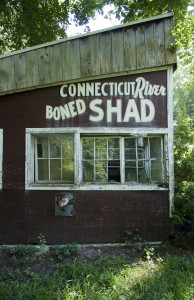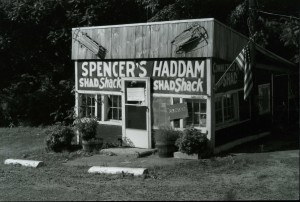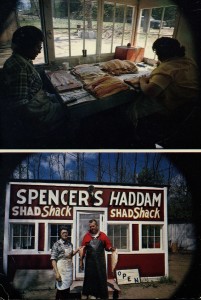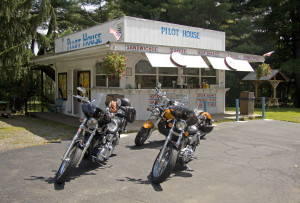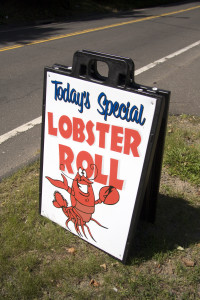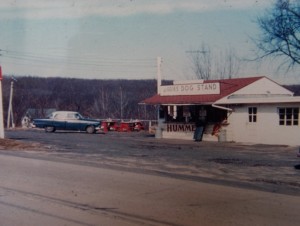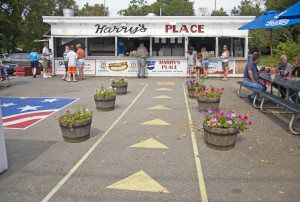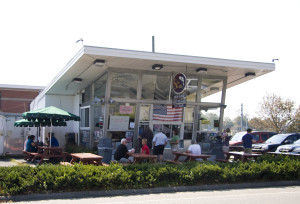By Mary M. Donohue SPRING 2012
LISTEN TO OUR PODCAST: Shack Attack! Summer Eats in Connecticut
Imagine it’s summertime and the living is easy. Proprietors of all kinds of seasonal roadside eateries take down the winter shutters and put up the awnings, get out the gaudy signs, restock the kitchen, hire the summer help, and prepare to feed the motoring public. From clam shacks to hot dog stands to hamburger joints and ice cream take-out windows, Connecticut’s food on the go, or “road food,” beckons along our two-lane highways. As Korky Vann of The Hartford Courant fondly recall in her article “Tasting Like Summer” (July 24, 2008),“These were the places that served foods we’d reminisced about all winter. … The places where any outfit dressier than shorts and flip-flops labeled you as a tourist.”
Connecticut’s own nationally renowned food critics Jane and Michael Stern have made a joint career of writing about non-franchised restaurants that serve American regional specialties prepared by short-order cooks, whom they call “America’s culinary folk artists.” The Sterns’ first book, Roadfood (Broadway Books, Revised Ed. 2005), chronicles the pair’s culinary travels throughout the United States, documenting hundreds of meals they ate at local restaurants. Their Web site, Roadfood.com, features reviews of more than130 Connecticut roadside restaurants—a must-read for the Connecticut road food enthusiast.
In Main Street to Miracle Mile, American Roadside Architecture (New York Graphic Society, 1985), historian Chester Liebs traces the evolution of roadside eateries from the stand-alone food shack to the modern drive-through fast food restaurant. Beginning in the 1920s, as more families were able to purchase automobiles, Americans of almost all classes took to the road for pleasure, taking a “drive in the country” or a family outing to the seashore. While many may have packed picnic lunches for short trips, others depended on roadside restaurants for sustenance along the way. Convenience and Americans’ willingness to eat out contributed to the growth of the restaurant industry. From 1921 to 1927, the number of restaurants of all kinds grew a whopping 40 percent as Americans increasingly embraced the pleasures of eating out. Food stands, once the province of the amusement park and county fair, began popping up at convenient stopping points along the road.
The typical food shack is a simple utilitarian building located on cheap, marginal land close to the road, with large, hand-painted signs, a walk-up window for ordering, a limited menu posted with prices, and nearby rustic seating. Fast Food, Roadside Restaurants in the Automobile Age (John Hopkins University Press, 1999) describes these roadside businesses as ideal for entrepreneurs with limited capital, noting that they were “hailed as one of America’s last ‘frontiers’ for independent businessman.” Blackie’s Hot Dog Stand in Cheshire, for example, began in 1925 as a gas station owned by a married couple. By 1928, the couple had built the enterprise into a successful restaurant business by serving hot dogs.
Many of us are charmed by the rustic, cobbled-together look of roadside food shacks. But the freewheeling character of their design has had its detractors. Liebs writes, “In 1928 Mrs. John D. Rockefeller and the American Civic Association even sponsored a competition to… ‘clean up’ the … hodgepodge of unsightly ‘hot dog’ stands and the accompanying riffraff of roadside markets….”
Though most food shacks are seasonal, some, such as Blackie’s, are open year-round. The once ubiquitous “shad shack” serving Connecticut’s springtime delicacy (and state fish) may soon be obsolete, as consumer demand for shad and the number of commercial fisherman of shad continue to dwindle. Here we offer a selection of food shacks that put Connecticut on the food-shack map. Read on and start your own list of roadside restaurants to visit when the weather gets warmer and they open for business.
Spencer’s Haddam Shad Shack
1146 Saybrook Road, Route 154, Haddam
Spencer’s Haddam Shad Shack, founded in 1930 by Benjamin Franklin Spencer, has not opened for some years. Over several generations, the Spencer family also operated Hubie’s Diner and H.B. Spencer & Son Amusements, Rides and Concessions.
The shad travel up the Connecticut River to spawn every spring for only six weeks, from April to the beginning of June, so shad shacks like Spencer’s served breakfast, lunch, and dinner to take in as much business as possible during the brief season. They offered scrambled eggs with shad roe, traditional baked shad, and broiled shad. Shad is a bony fish that requires an experienced hand to clean, debone, and fillet. Caught at night, shad was once shipped to Boston and New York, where it was served in upscale hotels and restaurants. Now it’s estimated that only three or four boats go out to catch the fish commercially. To experience this culinary sign of spring, look for the community shad bakes held in Essex, Old Saybrook, and Windsor.
The Pilot House
1364 Saybrook Road, Route 154, Haddam
In operation since 1945, The Pilot House is within view of the Connecticut River and probably takes its name from the wheelhouse of a ship. Before the advent of the interstate highways in the 1960s, State Route 154 was
the main road between Hartford and the shoreline. Local residents remember long lines of traffic along this route, sometimes backed up from Middletown to the shore, making this a great location for a food stand. The Pilot House is famous for its hot dogs, burgers, and, most of all, its homemade sweet relish and hot relish developed by long-time owners Aldo and Nellie Temelini.
Higgie’s
236 Saybrook Road, Route 154, Higganum, Haddam.
Higgie’s was started by the Smigel Brothers in 1947. Known for its secret recipe chili meat sauce that tops its best-selling hot dogs, Higgie’s is known for its inviting, colorful outdoor picnic tables. Ice cream milkshakes and cones round out the perfect summer meal of hot dogs, burgers, and fries.
Harry’s Place
104 Broadway, Colchester
Listed on the National Register of Historic Places, Harry’s Place continues the Colchester tradition of serving the summer tourism trade. Colchester is part of the area once known as the “Connecticut Catskills” for its wealth of Jewish resorts, boardinghouses, and guesthouses. Harry’s is renowned for its fresh hamburgers and divine onion rings.
Blackie’s Hot Dog
2200 Waterbury Road, Cheshire
Blackie’s eye-catching vintage red neon sign announces the home of Connecticut’s most architecturally outstanding hot dog stand. Two octagonal towers sheathed in red and white siding contain the dining rooms, connected by a counter and a row of shiny chrome counter stools. Two fold-up garage doors make way for the public to enter.
Blackie’s was established in 1928, and the current building was constructed in 1945. Blackie’s menu is limited to hot dogs, but they also sell bottles of their homemade relish to take home. Framed historic photos of the establishment are hung throughout the dining rooms.
The Sea Swirl
30 Williams Avenue, Junction of Routes 1 and 27, Mystic
The Sea Swirl is a roadside architecture “two for one.” The popular clam shack operates in a nearly pristine former Carvel ice cream shop. Founded by Greek immigrant Tom Carvel in 1929, the Carvel Ice Cream Company patented the all-glass-front, pitched-roof building design in 1947. An architecturally similar design was later made famous by the McDonald’s hamburger chain. The Sea Swirl was opened by the Blaney family in 1985 and has been visited by Food Network star Rachael Ray. Known regionally as home to outstanding whole-belly clams, the restaurant also offers soft-serve ice cream delights including sundaes, ice-cream floats, and ice-cream sodas.
EXPLORE!
Haddam Shad Museum, 212 Saybrook Road, Higganum. Open Sundays from mid-April to the end of June, 10 a.m. – 4 p.m., or by appointment. Call 860-267-0388.
LISTEN!
“Shack Attack,” Grating the Nutmeg, Episode 10
“Pleasant Valley Drive-In,” Grating the Nutmeg, Episode 12
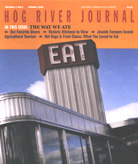
READ!
A Hip Road Trip: The History of the Berlin Turnpike
Lunch Wagon to Space-Age Diner: Connecticut’s First Fast Food Emporiums


